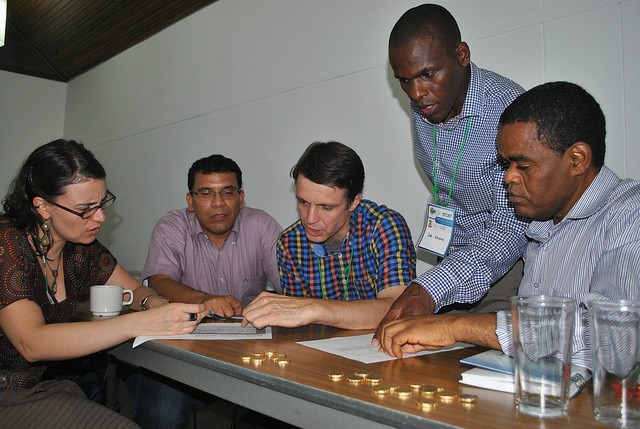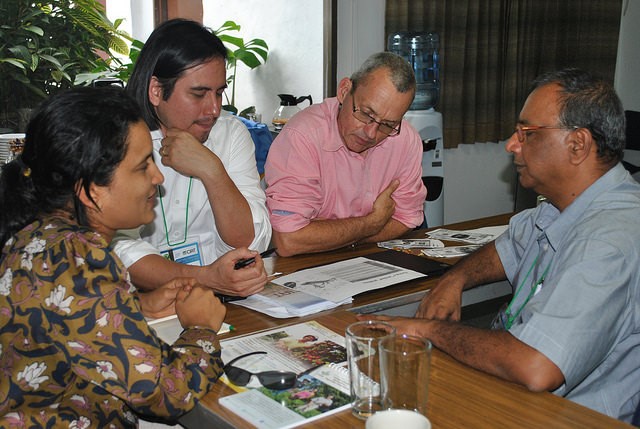…we often hear when introducing the Global Futures and Strategic Foresight project to our internal and external partners. Yes, let’s admit it: strategic foresight is still an unfamiliar concept to many, even among our colleagues. If you don’t understand something, you are often naturally biased against it. To change this undermining attitude towards our work, we at CIAT’s Global Futures and Strategic Foresight team decided to, so to speak, take this bias bull by the horns.
How do you present a complex subject to a diverse audience? One good way is to use games and roleplaying. The recent CIAT Annual Program Review “Science Innovation Marketplace” gave us a good opportunity to reach out to a range of potential partners and through a game help them better understand the value of strategic foresight and ex-ante economic impact assessment.
For the game, we split participants, who included colleagues from various CIAT offices and members of the Fondo Latinoamericano para Arroz de Riego (FLAR), one of CIAT’s key boundary partners, into three groups. Each represented one imaginary region with distinct socio-economic and environmental characteristics and was given a limited amount of hypothetical currency (called “CGIARs”) to be used for funding essential research addressing the most pressing food security issues in the regions.

Needless to stay, our participants had a difficult time! Which problems should be prioritized? What are the risks associated with certain investment decisions? Will the investments have significant impact?
At the end of the exercise, all groups gathered together again to discuss the experience and compare challenges faced by each team and approaches used for decision-making. Most of the participants said they recognized many of their own day-to-day challenges.
That moment was our chance! Having turned sceptics into a receptive audience, we presented ex-ante analysis and the ideas underlying strategic foresight. The participants were surprised to learn that the game itself was also a form of strategic foresight. Between our conversation about more involved quantitative foresight approaches and a qualitative foresight exercise, nearly everyone walked away with a better understanding of the value of Global Futures and Strategic Foresight efforts. Mission accomplished!
About the author
 Steven Prager is a Senior Scientist for Integrated Modeling at the International Center for Tropical Agriculture (CIAT) where he leads the Global Futures and Strategic Foresight activity. Prior to joining CIAT, Steve was an Associate Professor of Geography at the University of Wyoming. Steve holds a B.S. in earth science and an M.A. in geography from the University of North Carolina at Charlotte, and a PhD in Geography from Simon Fraser University.
Steven Prager is a Senior Scientist for Integrated Modeling at the International Center for Tropical Agriculture (CIAT) where he leads the Global Futures and Strategic Foresight activity. Prior to joining CIAT, Steve was an Associate Professor of Geography at the University of Wyoming. Steve holds a B.S. in earth science and an M.A. in geography from the University of North Carolina at Charlotte, and a PhD in Geography from Simon Fraser University.
PIM’s foresight modeling work (under research Flagship 1) analyzes alternative future scenarios and policy options to explore how new agricultural technologies and practices can best help reduce poverty and hunger while protecting natural resources. All 15 CGIAR Centers are currently participating in this work, together with partners from outside CGIAR. The research is realized through the Global Futures and Strategic Foresight Program (GFSF) facilitated by IFPRI and supported by the CGIAR Research Program on Policies, Institutions, and Markets (PIM), the Bill & Melinda Gates Foundation, and the CGIAR Research Program on Climate Change and Food Security (CCAFS).
Photos: CIAT, Flickr, Annual Program Review 2015



